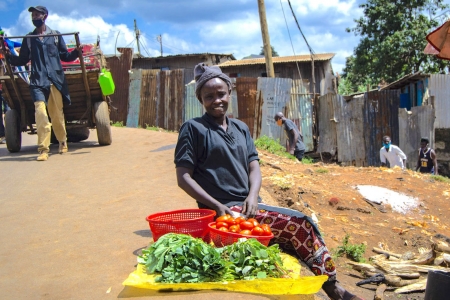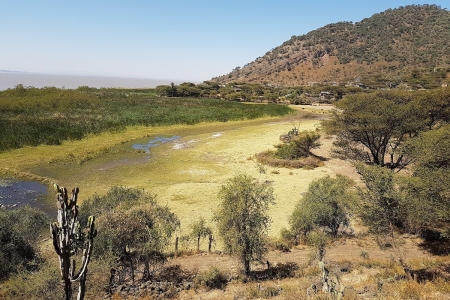This week the world marks the International Day for Biological Diversity. Coming on the heels of the UN’s landmark biodiversity report, we ask ourselves: how do we preserve bio-diverse ecosystems necessary for human existence while developing equitably? The Lead Author of the IPBES’s Africa regional assessment examines four potential paths.
Africa is rapidly developing, with the ADB estimating average growth to be 3.6% in 2019-20. Unfortunately this growth has been uneven and come at great cost to critical ecosystems and social stability. If African nations are going to reach their SDG targets by 2030 and their African Union Agenda by 2063, what has to change to ensure more ecologically sound, equitable development?
A new study, published in Liaison Énergie-Francophonie, suggests four potential development paths that consider social equity and the impact on the ecosystems.
1. Dependency Mode
Dependency Mode is a scenario in which ecosystems and their important services are assigned an economic value. Based on these values, market forces theoretically lead to less extractive, more sustainable use of natural resources, thereby slowing degradation. The free market would therefore deliver economic, social and environmental benefits.
This free market approach has some major downsides. Greenhouse gas emissions are projected to increase, and the commercial exploitation of environmental resources comes at the expense of local livelihoods, further marginalizing already vulnerable communities. Coupled with poor governance systems and insufficient environmental controls, tensions could flare between agricultural and pastoral communities who are suddenly unable to access the resources on which they historically depend, and the authorities and corporations who dictate the valuation.
In addition, given the projected rates of population and economic growth as well as a trend towards urbanization, cities are likely to become very populated but have poor infrastructure development and poor governance. This has the potential to lead to greater inequality for the people who migrate to cities.
2. Cocktail Approach
The Cocktail Approach depends on a social and political recognition of the value of healthy ecosystems balanced with strong economic growth. By increasing the area of protected lands, habitat loss and environmental degradation will be reduced. Land outside of these protected areas will be used for agricultural intensification with the aim to export high value crops.
Since this approach depends on strong central governments coordinating with global markets, wealth is likely to be distributed more evenly, reducing poverty and protecting land that would be under threat if resources run low. The problem with this approach is that smallholders are left out of the economic growth, since local scales of operation are not compatible with large scale agricultural intensification. In addition, because economic growth is based on exports, there is little room for diversity in economic activities.
This lack of diversity is not only harmful for livelihood activities, it also leads to a dependence on the environmental resources associated with agricultural and extractive commodities. While governments will have policies designed to actively mitigate climate change and expand protected ecosystems, this dependency on specific resources will likely lead to reduced biodiversity and degraded ecosystem services in the long-term, especially in unprotected areas.
3. Global Approach
In this scenario, environmental consciousness is heightened and technology provides solutions. Sustainable land management and strong incentives for low impact agriculture combined with high yield seed varieties and efficient technological solutions cause less environmental degradation. Effective governance leads to more effective environmental regulation, increasing protected area function and coverage, and allows for improved environmental cooperation across borders. Urbanization and large scale infrastructure for trade will occur, ideally developed by local capital, resources and manpower, leading to increased economic growth. There will also be a strong focus on investing in climate change mitigation.
However, concentrations of growth and capital will undoubtedly exist, leading to inequality; and temperatures are still expected to rise, despite the lower rates of population growth that are projected. In addition, natural resource management will probably still be state-owned, with countries looking after their own interests and providing little protection for common goods and continental biodiversity.
4. Africa First
As the name implies, this scenario prioritizes Africa’s needs vis-a-vis environmental protection, social equality and human welfare – with action towards sustainability taken largely at local levels. Local agriculture is carried out in a participatory manner, which, when combined with low population growth and the adoption of sustainable practices, drives lower rates of habitat loss.
While this approach would lead to local ‘sustainability hotspots,’ degradation would continue beyond these areas and, given the uncoordinated nature of local choices, habitats are fragmented and regional ecological integrity is poor in the long term.
However there are some major benefits to the Africa First model. Urbanization happens at a slower rate since rural communities will be the site of initial development. As economic options and natural resources become limited, young people, especially men, will leave for cities, reducing the pressures on natural resources in rural areas and allowing them to regenerate.
Another potential benefit is that local indigenous knowledge can be readily incorporated into the sustainable approaches, not only making them more effective, but increasing the rate of adoption. This integration of local knowledge in a participatory system is critical to the longevity of sustainable initiatives.
Finally, an Africa First scenario creates an environment in which African nations can take charge of their security and development interests. By reducing the dependence on foreign investment and creating a scenario in which local and national growth is worth protecting, conflict management techniques will be locally developed. After all, sustained development and growth are not possible without sustained peace.
So what’s the best option?
All of these options come with trade-offs, but Africa First takes into account three factors which the study calls the “3 key missing links:” youth inclusion, conflict resolution, and indigenous knowledge infusion. While the purpose of this study is to present possible scenarios to decision makers considering the future development of the continent, it is explicit in the importance of these three links in achieving resilience, sustainable development, and inclusive action. Without youth empowerment and livelihood enhancement to promote stability, political anarchy, strife and regime changes will persist. Without considering the social, political, and environmental stability in their development agendas, African nations will not be able to take charge of the future development of the continent.












